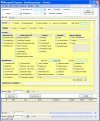Exploring Dental Providers' Workflow in an Electronic Dental Record Environment
- PMID: 27437058
- PMCID: PMC4941857
- DOI: 10.4338/ACI-2015-11-RA-0150
Exploring Dental Providers' Workflow in an Electronic Dental Record Environment
Abstract
Background: A workflow is defined as a predefined set of work steps and partial ordering of these steps in any environment to achieve the expected outcome. Few studies have investigated the workflow of providers in a dental office. It is important to understand the interaction of dental providers with the existing technologies at point of care to assess breakdown in the workflow which could contribute to better technology designs.
Objective: The study objective was to assess electronic dental record (EDR) workflows using time and motion methodology in order to identify breakdowns and opportunities for process improvement.
Methods: A time and motion methodology was used to study the human-computer interaction and workflow of dental providers with an EDR in four dental centers at a large healthcare organization. A data collection tool was developed to capture the workflow of dental providers and staff while they interacted with an EDR during initial, planned, and emergency patient visits, and at the front desk. Qualitative and quantitative analysis was conducted on the observational data.
Results: Breakdowns in workflow were identified while posting charges, viewing radiographs, e-prescribing, and interacting with patient scheduler. EDR interaction time was significantly different between dentists and dental assistants (6:20 min vs. 10:57 min, p = 0.013) and between dentists and dental hygienists (6:20 min vs. 9:36 min, p = 0.003).
Conclusions: On average, a dentist spent far less time than dental assistants and dental hygienists in data recording within the EDR.
Keywords: Time and motion studies; dental clinics; dental records; health information systems; process assessment (health care); workflow.
Conflict of interest statement
The authors declare that they have no conflicts of interest.
Figures








Similar articles
-
Current state of dental informatics in the field of health information systems: a scoping review.BMC Oral Health. 2022 Apr 19;22(1):131. doi: 10.1186/s12903-022-02163-9. BMC Oral Health. 2022. PMID: 35439988 Free PMC article.
-
Dental care providers' and patients' perceptions of the effect of health information technology in the dental care setting.J Am Dent Assoc. 2013 Sep;144(9):1022-9. doi: 10.14219/jada.archive.2013.0229. J Am Dent Assoc. 2013. PMID: 23989841
-
Barriers and facilitators for the implementation of electronic dental record systems: Perspectives from a developing country.Int J Med Inform. 2024 Dec;192:105622. doi: 10.1016/j.ijmedinf.2024.105622. Epub 2024 Sep 5. Int J Med Inform. 2024. PMID: 39244920
-
A preliminary model of work during initial examination and treatment planning appointments.Br Dent J. 2009 Jan 10;206(1):E1; discussion 24-5. doi: 10.1038/sj.bdj.2008.1151. Epub 2009 Jan 2. Br Dent J. 2009. PMID: 19119286
-
The impact of electronic medical record systems on outpatient workflows: a longitudinal evaluation of its workflow effects.Int J Med Inform. 2010 Nov;79(11):778-91. doi: 10.1016/j.ijmedinf.2010.09.006. Epub 2010 Oct 13. Int J Med Inform. 2010. PMID: 20947415 Review.
Cited by
-
Acceptance of voice assistant technology in dental practice: A cross sectional study with dentists and validation using structural equation modeling.PLOS Digit Health. 2024 May 14;3(5):e0000510. doi: 10.1371/journal.pdig.0000510. eCollection 2024 May. PLOS Digit Health. 2024. PMID: 38743686 Free PMC article.
-
Adoption of Electronic Dental Records: Examining the Influence of Practice Characteristics on Adoption in One State.Appl Clin Inform. 2018 Jul;9(3):635-645. doi: 10.1055/s-0038-1667331. Epub 2018 Aug 15. Appl Clin Inform. 2018. PMID: 30112742 Free PMC article.
-
Current state of dental informatics in the field of health information systems: a scoping review.BMC Oral Health. 2022 Apr 19;22(1):131. doi: 10.1186/s12903-022-02163-9. BMC Oral Health. 2022. PMID: 35439988 Free PMC article.
-
Influence of Practice Characteristics on the Adoption of Electronic Dental Records in Jeddah, Saudi Arabia.Healthc Inform Res. 2023 Jul;29(3):239-245. doi: 10.4258/hir.2023.29.3.239. Epub 2023 Jul 31. Healthc Inform Res. 2023. PMID: 37591679 Free PMC article.
References
-
- Irwin JY, Torres-Urquidy MH, Schleyer T, Monaco V. A preliminary model of work during initial examination and treatment planning appointments. Br Dent J 2009; 206(1): E1. - PubMed
-
- Wagner IV, Ireland RS, Eaton KA. Digital clinical records and practice administration in primary dental care. Br Dent J 2008; 204(7): 387-395. - PubMed
Publication types
MeSH terms
LinkOut - more resources
Full Text Sources
Other Literature Sources

